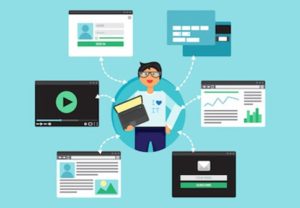10 Types Of Webinars Everyone Is Doing
In today’s business setting, there is no doubt that online courses are becoming an important ingredient. For certain period already, you have undoubtedly learned a lot regarding webinar marketing and communications, and you have attended a variety of webinars yourself. You may have even considered presenting your webinar, but you hesitate, worried about the worst: a botched event or a waste expenditure.
For many of these webinars, though, that’s not the situation when you get them right. Webinar networks stay in the top 5 platforms B2B companies use to handle their content marketing activities, as per the Content Marketing Institute. Also, the top 5 platforms for delivering material to a targeted audience include webinars as well as other interactive activities. So it’s best to sharpen up on your webinar usage scenarios and get a grip on how much you can make the most out of these for your business.
The subject and aim of a webinar, are indeed the key reasons that everybody participates. But the sort of event you’re hosting plays a major part as well. People do not want to partake in any event out there; they only like to engage in the kinds of webinars that suit their educational goals, and anything else is a waste of time.
The 10 types of webinar that everyone is doing in these days are:
Today, eLearning is commonly used as a classroom extension, typically addressing a subject only for academic reasons. This technique is common in many occupations where Continuing Education (CE) and re-certification are required to keep the industry up to date. And CE information is also given by way of a webinar.
Live and on-demand Continued Education webinars enable eLearners rank up in their profession without having to commute huge distances and disturb their plans. These online activities involve a virtual audience listening from a professional speaker on a particular subject, who uses interactive resources to perform surveys and interviews, field questions, and receive feedback. Until delivery, most CE webinars are peer-reviewed and are planned to fulfill state and federal specifications. CE webinars may also be accompanied by an exam, a test or quiz, an extra suggested lesson, or even digital CE when using a content delivery tool that provides Learning Management System basics.
The use of video for educating employees is growing increasingly in importance. Studies have shown that 98 percent of corporate leaders understand the importance of greater and quicker use of video for training workers, with 75 percent reporting that this medium is very useful. Although giving your employees live webinars, especially your remote employees offer them an opportunity to ask any questions, capturing a series of on-demand webinars where the group members can receive knowledge on various issues also offers a customized educational experience adhering to a “just-in-time” learning model.
Webinar production departments should concentrate on producing enjoyable educational and career learning content so that workers retain and adapt what they have learned to their work. It is so important to relate the content to their role in the organization, as well as to link their position to company objectives.
Product demonstrations not only give your business the chance to explain exactly everything they sell is the response to the pressure points of your prospective customer, but they are also a perfect way to promote a positive impression, distinguish your market from your competing company, and address any critical challenges that have your prospect on the fence. A good user interface is more critical than ever today, and a demo is a simple way to convince your webinar audience that with a smooth UX in mind, your app or platform was created.
Onboarding is one of most critical processes that you have with a potential client and the remainder of the relationship sets the stage. Research indicates that customer engagement is a crucial distinguishing factor for 62 percent of corporate clients, which leads as to why many businesses are diverting resources into customer success systems.
A crucial turning point is this stage of the buyer’s path. Your client has agreed to work with you, and they are sure to be excited about doing so. So the last thing you want is for the guilt of the customer to sink in! By making your customers know how and when to take better benefit of your item or brand.
Companies are constantly holding interactive town hall events to connect with all of their workers. Given that a virtual workspace is becoming more popular across various sectors, and that there are so many satellite office organizations working across the globe, it is important to be able to communicate with remote staff members. You will broadcast organization activities on a one-to-many scale connecting to 10,000+ participants using the best webinar services.
Lead generation webinars are designed to provide an audience that is likely to face a challenge in this field with educational material on a subject in which your organization has expertise. The main purpose is to gain new connections (or leads) with which after the webinar you may follow up. When during the presentation you develop adequate leadership development and integrity, you could just persuade them that they are a good match for your approach.
It is a challenge on its own to turn the eligible leads into paid clients. But your work is not done until you close the deal. Customer satisfaction is key in today’s dynamic market world and encouraging your customers to stick with you and remain, loyal customers is a never-ending task.
Webinars, though, make it a lot easier for the business partnerships to be nurtured. A webinar invitation offers the consumers the ability to keep updated about crucial business or product updates, which gives them yet another way to address their questions. Although you could create the same statements and have identical discussions across other platforms, webinars prove that in whichever way is comfortable for them, you are just trying to be an open and friendly business partner.
By providing a bridge among your useful content and your clients, webinars will help you develop your brand image and reputation as an industry leader. One way this is done is by putting the logo of your corporation in the online space of your webinar and naming all associated materials accordingly. Building faith in your brand is important, and webinars on thought leadership are a fantastic way to start.
Another application of webinars as a major shift in the industry takes place is to answer the audience. When challenges like these occur, always keep ahead by engaging quickly and efficiently with your clients as well as other bloggers in your network.
Webinars are the best way to add value to the bundle if your guests are members of your company and pay a monthly or yearly fee for your benefit programs. Some organizations provide its affiliates with webinars at no extra expense, thus charging others who are not part of the group a charge. This hardly provides the initiative with an additional advantage, it also helps the activities feel more exclusive.
Research also shows us that the third biggest explanation why individuals join professional organizations in the first place is continuous education benefits.You are not only promoting the experience of your company to both existing and prospective participants by providing educational webinars on timely business subjects, but you are also appealing to those seeking for access to advanced knowledge.
A round table conversation with a team of professionals from the industry is a perfect way to prove that you are in the loop and that the company is a pioneer in the field. The debate is normally guided during this form of webinar by a moderator who questions three to five panelists about their views and perspectives about different topics.
Another way to get the public interested is to invite applicants in preparation for queries. Your host will customize the session to suit the needs of the target audience with this knowledge and even train the panelists ahead of time. It also provides an incentive for the experts to focus on the issues and have more thought-out and/or data-backed replies.









